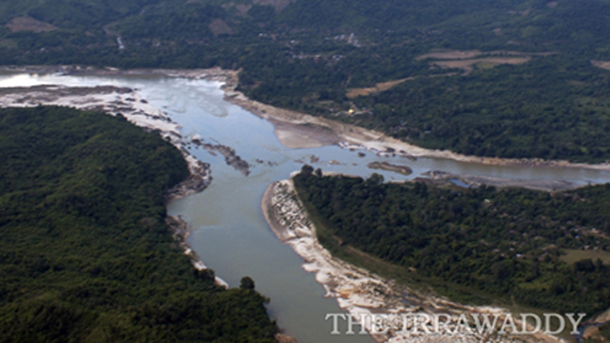MANDALAY— Burmese environmentalists and experts from the Mekong region are speaking out against degradation to watershed areas of the Irrawaddy River which they say has threatened the future of the river and its surrounding population.
At a public conference in Mandalay on Tuesday, they said damage to areas along the river had become more severe in recent years.
“Watershed areas of the upper segment of the Irrawaddy River have been destroyed due to the deforestation that results from wood production and mining. The main victims are the river and the people who live alongside it,” said Maung Maung Oo, a member of the Mandalay-based environmental group Green Activities.
Other environmentalists said mining in Kachin State and Sagaing Division had led to erosion along the riverbed, especially in Mandalay and Magwe divisions. The resulting sandbanks in the river have led to shallow water levels in the early summer.
“People living along the riverbank face a scarcity of clean water. In the monsoon season, an extreme rise in water levels causes flooding,” Maung Maung Oo said.
Researchers at the conference said gold miners and factories were illegally using mercury and discharging waste into the river, killing fish and affecting the livelihoods of fishermen.
To boost their catch, some fishermen have turned to electrical shockers, which have in turned harmed Irrawaddy dolphins, an endangered species.
“Some fishermen tap on their boats to call Irrawaddy dolphins, and once a school of fish forms they use their electric shockers to get all the fish. The dolphins cannot escape from the shock, and this is how we discovered one dead dolphin in late 2013,” said Su Hlaing Myint, an independent researcher on Irrawaddy dolphins who has collaborated with Green Activities.
“We have not been able to confirm how many dolphins have been killed. But when we went up to the Kyauk Myaung area [of Sagaing], we found only 24 dolphins. We also saw the flesh of dolphins being dried in the sun, to produce oil,” she added. The oil is reportedly in high demand at Chinese markets for medicinal purposes.
“I’m afraid if there is a flood of Chinese workers for various projects, such as the Myitsone Dam, they will destroy our dolphins and many endangered species,” she said.
The Mytisone Dam project in Kachin State was suspended by President Thein Sein in 2011 due to opposition by local people. The hydropower project is a joint venture by the state-owned China Power Investment Corporation (CPI), the Burma government and Burmese conglomerate Asia World. It will produce electricity mainly for China.
Environmentalists say the project could lead to environmental degradation not only in the Myitsone area, but also in the upper region along the Maykha and Malikha rivers, where the Irrawaddy River begins. They also worry about consequences for the delta region, where most of the country’s rice is produced.
“The Irrawaddy is a main artery of the country. Whether there is a dam or not, the destruction of the river is terrible. We need to save it immediately,” said U Ohn, vice president of the Rangoon-based Forest Resource Environment Development and Conservation Association (FREDA).
“There’s no doubt that if there’s a big dam up there, the situation will worsen,” he added.
More than 50 environment activists, researchers and volunteers across the country plan to gather on March 14, the International Day of Action for Rivers, to organize an awareness campaign. They will meet at Tan Phae village, Kachin State, at the confluence of the Maykha and Malikha rivers.
Other participants at the conference in Mandalay were from the Mekong Energy and Ecology Network, the Mandalay-based network Green Future network, and the Rangoon-based Promotion of Indigenous and Nature Together (POINT).

















